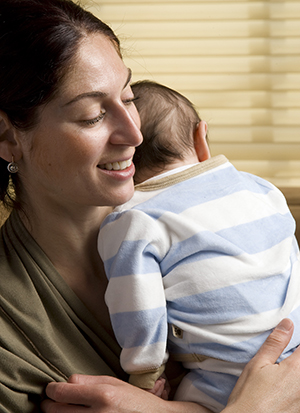After a Vaginal Birth
After a Vaginal Birth

Right after the delivery
Your temperature and blood pressure will be taken until they are stable. A nurse or other healthcare provider will observe you as you rest. You may have afterbirth pains. These are cramps caused by the uterus shrinking. Sanitary pads are used to soak up the discharge of the uterine lining. To make sure that you aren’t bleeding too much, the pad will be checked. And the firmness of your uterus will be checked. To do this, a nurse will gently push down on your stomach. If you had anesthesia, you’ll be watched closely until you can feel and move your toes. If you have perineal pain (pain between the vagina and anus), an ice pack can help.
Newborn care
While still in the hospital or birth center, you’ll learn how to hold and feed your baby. You will also be given instructions on how to care for your baby. This includes bathing and feeding.
Preparing to go home
You may be anxious to go home as soon as possible. Before you and your baby go home, a healthcare provider will check to be sure you are healthy enough to take care of your baby and yourself. You’re ready to go home when:
-
You can walk to the bathroom and use the bathroom without help.
-
You can eat solid food and swallow pills (if needed).
-
You have no sign of infection or other health problems, including fever.
-
You have adequate pain control.
-
Your bleeding isn't excessive.
-
You are able to care for your newborn and are emotionally stable.
Before leaving the hospital or birth center, you’ll be given written instructions for home self-care after vaginal delivery. Be sure to follow these instructions carefully. If you have questions or concerns, talk about them now.
If you have stitches
You may have received stitches in the skin near your vagina. The stitches might have closed an episiotomy (an incision that enlarges the opening of the vagina). Or you may have needed stitches to repair torn skin. Either way, your stitches should dissolve within weeks. Until then, you can help reduce discomfort, aid healing, and reduce your risk of infection by keeping the stitches clean. These tips can help:
-
Gently wipe from front to back after you urinate or have a bowel movement.
-
After wiping, spray warm water on the area. Or you can have a sitz bath. This means sitting in a tub with a few inches of water in it. Then pat the area dry or use a hairdryer on a cool setting.
-
Do not use soap or any solution except water on the area.
-
You can take a shower unless told not to.
-
Change sanitary pads at least every 2 to 4 hours.
-
Place cold or heat packs on the area as directed by your healthcare providers or nurses. Keep a thin towel between the pack and your skin.
-
Sit on firm seats so the stitches pull less.
Postnatal follow-up
Schedule a postnatal follow-up exam with your healthcare provider for about 6 weeks after delivery. During this exam, your uterus and vaginal area will be checked. Contact your healthcare provider if you think you or your baby are having any problems.
When to call your healthcare provider
Call your healthcare provider right away if you have:
-
A fever of 100.4°F (38.0°C) or higher
-
Bleeding that needs a new sanitary pad after an hour, or large blood clots
-
Pain in your vagina that gets worse and isn't relieved with medicine
-
Swelling, discharge, or increased pain from vaginal tear or episiotomy
-
Burning, pain, red streaks, or lumpy areas in your breasts that may be accompanied by flu-like symptoms
-
Cracks, blisters, or blood on your nipples
-
Burning or pain when you urinate
-
Nausea or vomiting
-
Dizziness or fainting
-
Feelings of extreme sadness or anxiety, or a feeling that you don’t want to be with your baby
-
Belly pain that isn’t relieved with medicine
-
Vaginal discharge that has a bad odor
-
No bowel movement for 5 days
-
Painful urination, or inability to control urination
-
Redness, warmth, or pain in the lower leg
-
Chest pain
Updated:
July 02, 2019
Sources:
Overview of Postpartum Care. UpToDate
Reviewed By:
Burd, Irina, MD, PhD,Goode, Paula, RN, BSN, MSN